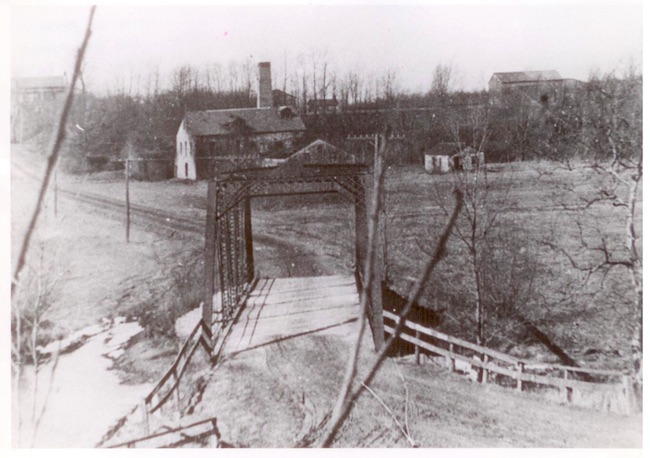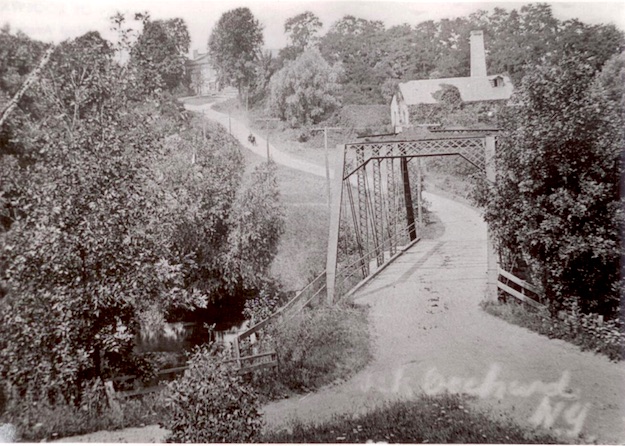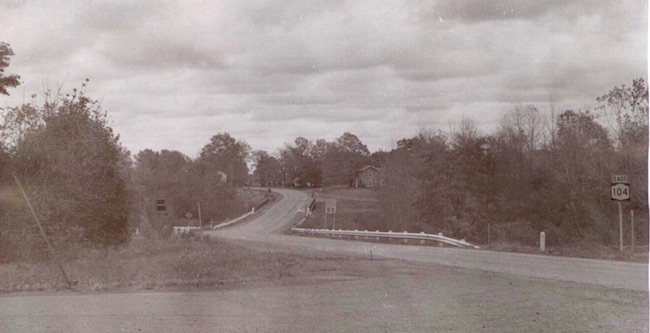Community was creative with early bridges over Oak Orchard in Ridgeway
Current bridge on 104 will soon be replaced

Photographs courtesy of Town of Ridgeway Historian’s office: This view shows the iron bridge over Oak Orchard Creek, looking west on Ridge Road.
By Catherine Cooper, Orleans County Historian
“Illuminating Orleans” – V. 1, No 10
RIDGEWAY – Which are you most likely to say, “The bridge is out?” or “The bridge is closed?”
This topic generated some lively discussion. An informal survey found that more people are likely to say “closed” rather than “out.”
Regardless of preferred usage, inconvenience ensues when a bridge is “closed” or “out” as those who travel or live on Route 104 will find when the bridge over the Oak Orchard Creek on Route 104 will soon close to traffic for five months.
Oak Orchard Creek originates in the Tonawanda Swamp. Joined by numerous streams as well as Otter Creek and Marsh Creek, it flows into Lake Ontario at the Oak Orchard Harbor.
Crossing the Oak Orchard Creek proved challenging for the early settlers. Describing his family’s journey in 1810, Seymour Murdock recalled that the area of bank cleared for crossing was designed for “Yankee” wagons which were narrow. However, their wagon was a wider Pennsylvania wagon, and the crossing proved very difficult. One little brother fell out and would have been left behind, had he not yelled lustily.

Later view of the iron bridge over Oak Orchard Creek on Ridge Road
For many years, a felled tree, with its upper limbs trimmed would serve as a footbridge. In 1825, the Supervisors of Orleans County were authorized by the Legislature to raise $1,000 by tax to build a plank bridge over the Oak Orchard Creek.
This plank bridge greatly facilitated travel along Route 104, but it deteriorated over time. In October 1876, a herd of 21 fat cattle caused it to give way when they crossed. The cattle were not injured though they fell 18 feet. According to the Medina Tribune, the bridge was “a total wreck.” However, “travel on this road will not be obstructed by this accident.”
The plank bridge was replaced by an iron bridge. By the 1950s, this bridge was no longer suited to the increased volume of vehicular traffic. Also, the curved approach and narrow width were cited as factors in several accidents. A new, wider bridge was built by the State Dept. of Public Works in 1954, at a cost of $175,000. The curve was straightened by moving the highway several yards to the north of the original highway. The bridge was resurfaced in 1981.
The new bridge will replace the bridge built in 1954. Featuring two 12-foot wide travel lanes, wider shoulders and new approaches, it is to be built by the Union Concrete and Construction Corporation of West Seneca. The cost of bridge-building has increased since 1954, from $175,000 to $2.65 million. The new bridge is expected to last 75 years, so we will not need to debate whether that particular bridge is “closed” or “out” until 2096.

View of Oak Orchard Creek bridge, looking east on Ridge Road









































































